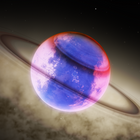|
Star/Galaxy movement
|
|
| pzampella | Date: Tuesday, 05.08.2014, 03:40 | Message # 1 |
 Space Pilot
Group: Users
 Venezuela
Venezuela
Messages: 115
Status: Offline
| It would be nice to add the movements of the stars around the galaxy and the movements of the galaxies. I understand it is not easy because it is different for each object, but it could be an average. I also understand that some of those movements are extremly slow, so it might be good to increase the time limit of the simulation. Opinions?
|
| |
| |
| Cesrate | Date: Tuesday, 05.08.2014, 05:26 | Message # 2 |
 Astronaut
Group: Users
 China
China
Messages: 68
Status: Offline
| ……
So, to simulate the gravity of the whole galaxy?
OMG.
|
| |
| |
| Wwadlol | Date: Tuesday, 05.08.2014, 06:22 | Message # 3 |
 Space Pilot
Group: Users
 Norway
Norway
Messages: 107
Status: Offline
| Yeah, but if every star in a galaxy orbits the center, wouldn't frame rate be an issue?
So if that doesn't work, maybe the galaxy models should be animated instead, so it looks like the stars are moving.
|
| |
| |
| Qnzi | Date: Tuesday, 05.08.2014, 07:14 | Message # 4 |
|
Observer
Group: Users
 China
China
Messages: 11
Status: Offline
| Quote Wwadlol (  ) Yeah, but if every star in a galaxy orbits the center, wouldn't frame rate be an issue? So if that doesn't work, maybe the galaxy models should be animated instead, so it looks like the stars are moving.
In that case, the movement may be unreal: Inner loops move slower when outer loops move faster. On the other hand, we are looking forward to system collision, but it won't show in your scenario.
However, 100% accurate simulation is impossible under current PC tech, some simplification is required. We have to make a choice, Spaceengineer have to make a chioce.
|
| |
| |
| FastFourierTransform | Date: Tuesday, 05.08.2014, 10:25 | Message # 5 |
 Pioneer
Group: Local Moderators
 Spain
Spain
Messages: 542
Status: Offline
| Maybe moving stars could be implemented for Globular Clusters.
Hubble team has made some calculations of the stellar kinematics of Omega Centauri. It looks utterly beautifull!!
http://www.spacetelescope.org/videos/heic1017a/
I think this is a project for the far future, so be patient, maybe you get a surprise. What I see is that Vladimir don't add unrealistic things to the engine, so I suppose that if one day we have stellar motion he will represent the phenomenon quite in detail. I mean, for example, that if stars are moving in clusters like this [https://www.youtube.com/watch?v=1ekzgnn_iIw] then is probable that the orbits of planets get eccentric in close passing stars, or that some planets dissapear and become rogue planets. I mean that maybe you zoom into a star and see a system, then you pass some 10 million years and zoom again to see all a new configuration for the system. Probably SE would have both things simultaneusly to be more realistic.
|
| |
| |
| SpaceEngineer | Date: Tuesday, 05.08.2014, 10:48 | Message # 6 |
 Author of Space Engine
Group: Administrators
 Russian Federation
Russian Federation
Messages: 4800
Status: Offline
| I wrote this many times: I have no idea how to implement procedural moving stars. I can model a trajectory of a single star (semi-analytic approach), but the problem is the star generating/rendering system itself. SE don't render and don't generate star blocks what are not visible to the camera (cutted out by the screen edge or by distance (based on the most bright star in the block)). But if your stars are moving, how will you get their coordinates? You must generate them first, move along orbits to current position to calculate coordinates, and only then you be able to say if these stars are visible and needed to generate and render. So system simply will not work.

|
| |
| |
| pzampella | Date: Tuesday, 05.08.2014, 14:03 | Message # 7 |
 Space Pilot
Group: Users
 Venezuela
Venezuela
Messages: 115
Status: Offline
| I think I got it... Maybe in a far future you will come with an idea, because this subject is very interesting! In any case, we will be waiting for whatever you improve in the next update! Thx!
|
| |
| |
| TemperateTerraIsBest | Date: Sunday, 15.02.2015, 01:59 | Message # 8 |
 Space Tourist
Group: Users
 United States
United States
Messages: 32
Status: Offline
| Ooooh, a hard one to implement!  Added (15.02.2015, 00:59)
---------------------------------------------
Cesrate, the whole universe 
Sample Text
|
| |
| |
| Watsisname | Date: Sunday, 15.02.2015, 06:16 | Message # 9 |
 Galaxy Architect
Group: Global Moderators
 United States
United States
Messages: 2613
Status: Offline
| TemperateTerraIsBest, please don't revive old threads unless you have something meaningful to add to it.

|
| |
| |
| HarbingerDawn | Date: Sunday, 15.02.2015, 11:50 | Message # 10 |
 Cosmic Curator
Group: Administrators
 United States
United States
Messages: 8717
Status: Offline
| Quote Watsisname (  ) TemperateTerraIsBest, please don't revive old threads unless you have something meaningful to add to it.
In fact, this is good advice to follow regardless of the age of a thread.
All forum users, please read this!
My SE mods and addons
Phenom II X6 1090T 3.2 GHz, 16 GB DDR3 RAM, GTX 970 3584 MB VRAM
|
| |
| |
| RockoRocks | Date: Sunday, 15.02.2015, 13:27 | Message # 11 |
 World Builder
Group: Users
 Belgium
Belgium
Messages: 674
Status: Offline
| Quote HarbingerDawn (  ) In fact, this is good advice to follow regardless of the age of a thread.
Perhaps make this a new forum rule?
I will be inactive on this forum for the time being. Might come back eventually
AMD AR-3305M APU w/ Radeon HD 1.90 GHz 6,00 GB RAM
|
| |
| |
| HarbingerDawn | Date: Sunday, 15.02.2015, 13:40 | Message # 12 |
 Cosmic Curator
Group: Administrators
 United States
United States
Messages: 8717
Status: Offline
| Quote RockoRocks (  ) Perhaps make this a new forum rule?
Should "don't make a post that doesn't contribute anything" really have to be a rule? Anyway this is off-topic.
All forum users, please read this!
My SE mods and addons
Phenom II X6 1090T 3.2 GHz, 16 GB DDR3 RAM, GTX 970 3584 MB VRAM
Edited by HarbingerDawn - Sunday, 15.02.2015, 13:41 |
| |
| |
| xdark_princex | Date: Friday, 26.08.2016, 06:17 | Message # 13 |
|
Observer
Group: Users
 Pirate
Pirate
Messages: 14
Status: Offline
| this would be useful if SE could simulate a few billion years then watch andromeda and milky way collide 
Resistance Is Futile, You Will Be Assimilated.
|
| |
| |
| Watsisname | Date: Friday, 26.08.2016, 21:17 | Message # 14 |
 Galaxy Architect
Group: Global Moderators
 United States
United States
Messages: 2613
Status: Offline
| Yeah, if it could. This is the harsh mathematical reality of why it can't.
Assume the Milky Way and Andromeda contain a combined 100 billion stars. Then to simulate the merger by calculating gravitational force interaction between each star, we must compute N*(N-1) = 1022 interactions per time step. Assume (wrongly) each interaction is only one iteration on a processor. Then on a 3Ghz processor, each time step takes about 100,000 years. Meaning for time-steps small enough to smoothly simulate the merger, it takes longer to simulate it than it takes for the real merger to occur. You would be better off watching the real thing in real time. 
The use of treecode reduces the computation requirements from order N2 to order NlogN. For large N, this is a huge improvement, and in this case each time step takes ~15 minutes. For reasonable time-steps, simulating the whole merger might take a few months to years. Better; now a super-computer can do it. But it's still something you're not going to see on your home PC anytime soon.
Universe Sandbox uses the direct method which is N2, which is also why it must limit itself to very small numbers of particles.

|
| |
| |
| FastFourierTransform | Date: Friday, 26.08.2016, 21:27 | Message # 15 |
 Pioneer
Group: Local Moderators
 Spain
Spain
Messages: 542
Status: Offline
| Wow very interesting Watsisname. The sense of magnitude is always important. I knew that this was difficoult or impossible but now I understand in what limits we are talking about.
|
| |
| |